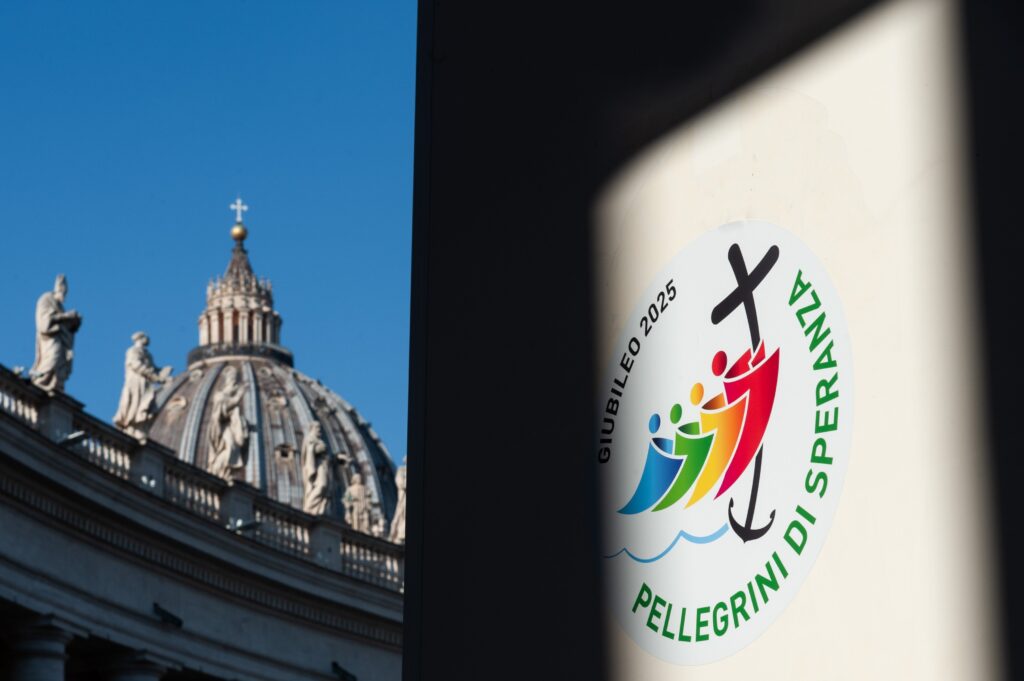
10 Things To Know About Jubilee 2025, the Holy Year That Begins December 24
By: Our Sunday Visitor
While Rome is seizing the opportunity for renewal, that is ultimately the jubilee’s expectation for the entire Church

(OSV News) — Signs around the Eternal City declare “Roma si trasforma”— “Rome is transformed”— to explain the ubiquitous infrastructure projects underway, including the restoration of iconic sculptures and monuments, ahead of Jubilee 2025, a Holy Year that begins Christmas Eve.
While the metropolis is seizing the opportunity for renewal, that is ultimately the jubilee’s expectation for the entire Church. “For everyone, may the Jubilee be a moment of genuine, personal encounter with the Lord Jesus, the ‘door’ … of our salvation, whom the Church is charged to proclaim always, everywhere and to all as ‘our hope,'” Pope Francis wrote in the document that officially declared the year.
Here are 10 things to know about the upcoming Jubilee Year.
1. A jubilee year, also known as a “holy year,” is a special year in the life of the church currently celebrated every 25 years. The most recent ordinary jubilee was in 2000, with Pope Francis calling for an Extraordinary Jubilee Year of Mercy in 2015-2016. Jubilee years have been held on regular intervals in the Catholic church since 1300, but they trace their roots to the Jewish tradition of marking a jubilee year every 50 years.
According to the Vatican website for the jubilee, these years in Jewish history were “intended to be marked as a time to re-establish a proper relationship with God, with one another, and with all of creation, and involved the forgiveness of debts, the return of misappropriated land, and a fallow period for the fields.”
2. Jubilee 2025 opens Christmas Eve, December 24, at 7 p.m., with the rite of the opening of the Holy Door at St. Peter’s Basilica in the Vatican immediately before Pope Francis celebrates midnight Mass. Holy Doors will also be opened at Rome’s three other major basilicas: St. John Lateran on December 29, St. Mary Major on January 1, and St. Paul’s Outside the Walls on January 5.
A Holy Door will also be opened on December 26 at Rebibbia Prison, a Roman prison Pope Francis has visited twice before to celebrate Mass and wash inmates’ feet on Holy Thursday.
The doors represent the passage to salvation Jesus opened for humanity. In 1423, Pope Martin V opened the Holy Door in the Basilica of St. John Lateran — the Diocese of Rome’s cathedral — for the first time for a jubilee. For the Holy Year of 1500, Pope Alexander VI opened Holy Doors at Rome’s four main basilicas. At the end of a holy year, the Holy Doors are formally closed and then bricked over by masons.
3. The theme of the Holy Year is “Pilgrims of Hope.” The papal bull, issued May 9, that introduced the coming Jubilee Year is titled “Spes Non Confundit,” or “Hope does not disappoint,” drawn from Romans 5:5. “Everyone knows what it is to hope,” Pope Francis wrote. “In the heart of each person, hope dwells as the desire and expectation of good things to come, despite our not knowing what the future may bring.
“Even so, uncertainty about the future may at times give rise to conflicting feelings, ranging from confident trust to apprehensiveness, from serenity to anxiety, from firm conviction to hesitation and doubt,” he continued. “Often we come across people who are discouraged, pessimistic, and cynical about the future, as if nothing could possibly bring them happiness. For all of us, may the Jubilee be an opportunity to be renewed in hope. God’s word helps us find reasons for that hope.”
Pope Francis also hopes the year draws Catholics toward patience, which he described in “Spes Non Confundit” as a “virtue closely linked to hope,” yet can feel elusive in “our fast-paced world, we are used to wanting everything now.”
4. Drawing on their Jewish roots, jubilee years emphasize the sacrament of reconciliation and restoring relationships with God. They also provide an opportunity for a special jubilee indulgence, which can remove the residual effects of sin through the grace of Christ.
5. The year calls Christians to action. Pope Francis called for “signs of hope” in the Jubilee Year, including the desire for peace in the world, openness to life and responsible parenthood, and closeness to prisoners, the poor, the sick, the young, the elderly, migrants, and people “in difficult situations.” Pope Francis has called on affluent countries to forgive the debts of countries that would never be able to repay them, and address “ecological debt,” which he described as “connected to commercial imbalances with effects on the environment and the disproportionate use of natural resources by certain countries over long periods of time.”
6. Expect an influx of pilgrims in the Eternal City. Italy’s National Tourist Research Institute projects 35 million visitors in 2025, nearly triple its 13 million visitors in 2023. Pilgrimage is a “fundamental” part of jubilee events, Pope Francis said in “Spes Non Confundit.” “Setting out on a journey is traditionally associated with our human quest for meaning in life. A pilgrimage on foot is a great aid for rediscovering the value of silence, effort, and simplicity of life,” he wrote.
He noted that jubilee pilgrims are likely to visit Rome’s Christian catacombs and its seven pilgrim churches — the basilicas of St. Peter, St. Mary Major, St. John Lateran, St. Paul Outside the Walls, St. Lawrence, Holy Cross and St. Sebastian — destinations St. Philip Neri popularized in the 16th century with a 15-mile walk. Twelve other Roman churches, including the Sanctuary of Divine Love in southeast Rome, are designated “jubilee churches” intended as gathering spots for pilgrims during the jubilee.
Experts in the travel and hospitality industries suggest anyone heading to Rome in 2025 — pilgrim or not — book accommodations, tickets, and tours in advance. Visitors may also be expected to pay an increased tourist tax, depending on their type of accommodations.
7. Major events are happening in Rome, including jubilee gatherings with liturgies, speakers, and papal audiences to celebrate different groups within the church. The first is the Jubilee of the World of Communications January 24-26, followed by the Jubilee of the Armed Forces, Police, and Security Personnel February 8-9. The jubilee also includes gatherings for artists (February 15-18), deacons (February 21-23), and even marching bands (May 10-11). Some of these special gatherings will coincide with major canonizations, such as the canonization of Blessed Carlo Acutis during the Jubilee of Teenagers on April 25-27, and the canonization of Blessed Pier Giorgio Frassati during the Jubilee of Young People on July 28-August 3.
Expect some events to highlight the 1,700th anniversary of the Council of Nicaea, from which Christians received the Nicene Creed. This year, despite different liturgical calendars, the dates for celebrating Easter align in the Catholic Church and the Orthodox Church, leading some, including Pope Francis, to call for a “decisive step forward towards unity around a common date for Easter,” which was discussed in 325 at the Council of Nicaea.
8. Expect Rome to sparkle and shine. Many famous sites and artworks in Rome and at the Vatican have been cleaned or restored for the jubilee, much to the chagrin of many tourists in 2024, who found major monuments obscured by fencing, scaffolding, and tarps. Many of those projects are expected to be completed with a fresh-face reveal in time for the jubilee. In October, St. Peter’s Basilica revealed its newly restored baldacchino, designed by Gian Lorenzo Bernini in the 1600s, after 10 months of work. Also receiving cleaning or restoration are Michelangelo’s Pietà, Bernini’s Fountain of the Four Rivers in Piazza Navona, and Bernini’s angels on the Ponte Sant’Angelo.
9. While many jubilee events will take place in Rome and at the Vatican, it’s a celebration for the whole church. On December 29, diocesan bishops are expected to open the Holy Year locally with Masses at their cathedrals and co-cathedrals. Catholics are encouraged to make pilgrimages to their cathedral during the year and should watch diocesan communications for local events. While Pope Francis encouraged bishops to designate Holy Doors for their own cathedrals during the Jubilee Year of Mercy in 2015, there will only be Holy Doors at the Vatican and in Rome this year.
10. The Jubilee Year concludes with the closing of the Holy Door at St. Peter’s Basilica on January 6, 2026, on the feast of the Epiphany. However, the Holy Doors at Rome’s other major basilicas will close on December 28, 2025, the same day dioceses are to end local celebrations of the Holy Year.
The Jubilee Year also looks ahead to 2033, when the church will mark the 2,000th anniversary of Jesus’ passion, death, and resurrection, which Pope Francis called “another fundamental celebration for all Christians.”
– – –
Maria Wiering is senior writer for OSV News.

